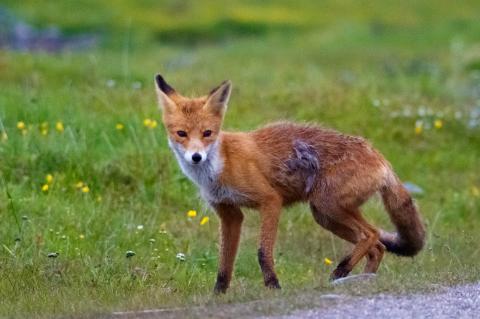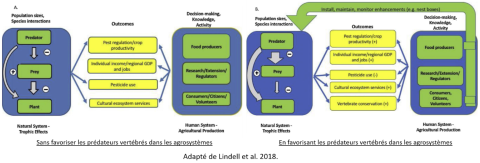
Reinforcing landscape structures conducive to the presence of declining vertebrate predators
In peri-urban agricultural environments, human activities and changes in land use have a particularly strong impact on local biodiversity. However, they are also an opportunity for certain species to develop, thanks to the diversity of crops and ecosystems.
One of the main problems encountered by farmers on the Saclay plateau, in addition to the severe constraints currently imposed by the fragmentation of the land by urbanization and associated means of transport1, is the high abundance of certain crop eating species, notably corvids and pigeons2.
These crop-eating species are the usual prey of vertebrate predators, which are in decline. The regulation of crop-eating species by vertebrate predation is not only (i) essential to the ecological functioning of ecosystems, but (ii) can greatly contribute to the protection of crops and their yields3. Regulation by predation is largely underestimated by the various players working in agricultural environments.
The regulation of crop-consuming species by vertebrate predation is not only an ecological function essential to the maintenance and development of biodiversity, but also an ecological service that is largely underestimated and under-utilized by the various players working in the agricultural sector. In this project, we propose to:
- study the community of mesopredator mammals present on the Saclay agricultural plateau in order to
- estimate the densities of some of the most abundant mesopredator species, such as the red fox, and
- propose the reinforcement of certain landscape structures most favorable to the presence of these mesopredators.
The methodology employed here is to grid the entire Saclay plateau using photographic traps, and to use the Random Encounter Model method to estimate population densities. The entire image database will be hosted on a university server. Photos will be analyzed and managed using DeepFaune software, with recent innovations in deep learning. The expected results are robust estimates of mesopredator densities, where potential estimation biases will be compared using statistical methods to obtain tighter confidence intervals.
We will produce a map of the landscape's structuring elements in order to highlight landscape structures that promote ecological continuity. Lastly, we will produce a summary note for farmers to scientifically compare the different techniques and protocols for using drones to limit the presence of the main crop eaters.
The ultimate aim of this project is to demonstrate and promote the need for functional food chains (presence of vertebrate predators) in order to maintain and develop biodiversity in these agro-ecosystems, guaranteeing the ecological service of regulation that can limit crop damage.
.
.
This project (2023-2024) involves:
- 3 C-BASC laboratories and the Graduate school Biosphera: Elsa Bonnaud (ESE) as project leader, Adrienne Ressayre (GQE Le Moulon) and Michel Bertrand (Agronomy).
- 1 external laboratory: UMR Herbivores/INRAE in Clermont-Ferrand
- the Terre & Cité association
References:
1. Leadley et al. 2023
2.Sausse et al. 2021
3.Garbach et al. 2017, Montoya et al. 2019

